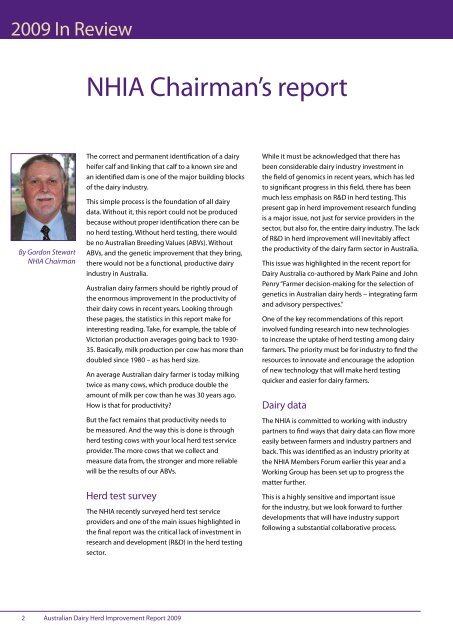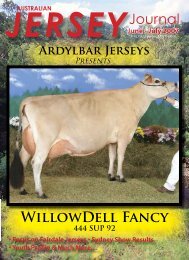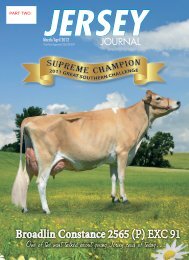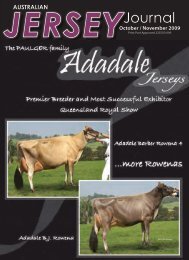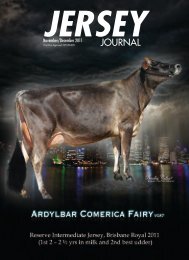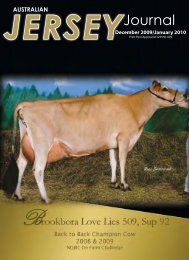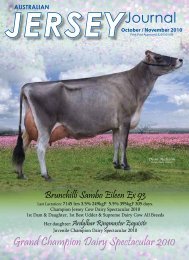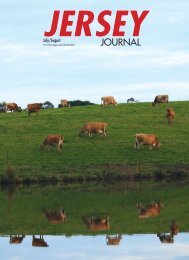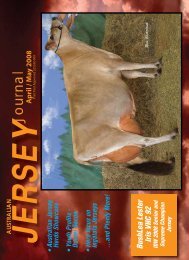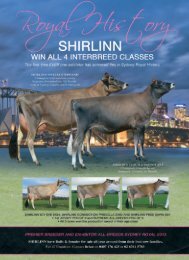NHIA 2008/09 National Herd Recording Statistics - Australian Jersey ...
NHIA 2008/09 National Herd Recording Statistics - Australian Jersey ...
NHIA 2008/09 National Herd Recording Statistics - Australian Jersey ...
You also want an ePaper? Increase the reach of your titles
YUMPU automatically turns print PDFs into web optimized ePapers that Google loves.
20<strong>09</strong> In Review<br />
<strong>NHIA</strong> Chairman’s report<br />
By Gordon Stewart<br />
<strong>NHIA</strong> Chairman<br />
The correct and permanent identification of a dairy<br />
heifer calf and linking that calf to a known sire and<br />
an identified dam is one of the major building blocks<br />
of the dairy industry.<br />
This simple process is the foundation of all dairy<br />
data. Without it, this report could not be produced<br />
because without proper identification there can be<br />
no herd testing. Without herd testing, there would<br />
be no <strong>Australian</strong> Breeding Values (ABVs). Without<br />
ABVs, and the genetic improvement that they bring,<br />
there would not be a functional, productive dairy<br />
industry in Australia.<br />
<strong>Australian</strong> dairy farmers should be rightly proud of<br />
the enormous improvement in the productivity of<br />
their dairy cows in recent years. Looking through<br />
these pages, the statistics in this report make for<br />
interesting reading. Take, for example, the table of<br />
Victorian production averages going back to 1930-<br />
35. Basically, milk production per cow has more than<br />
doubled since 1980 – as has herd size.<br />
An average <strong>Australian</strong> dairy farmer is today milking<br />
twice as many cows, which produce double the<br />
amount of milk per cow than he was 30 years ago.<br />
How is that for productivity?<br />
But the fact remains that productivity needs to<br />
be measured. And the way this is done is through<br />
herd testing cows with your local herd test service<br />
provider. The more cows that we collect and<br />
measure data from, the stronger and more reliable<br />
will be the results of our ABVs.<br />
<strong>Herd</strong> test survey<br />
The <strong>NHIA</strong> recently surveyed herd test service<br />
providers and one of the main issues highlighted in<br />
the final report was the critical lack of investment in<br />
research and development (R&D) in the herd testing<br />
sector.<br />
While it must be acknowledged that there has<br />
been considerable dairy industry investment in<br />
the field of genomics in recent years, which has led<br />
to significant progress in this field, there has been<br />
much less emphasis on R&D in herd testing. This<br />
present gap in herd improvement research funding<br />
is a major issue, not just for service providers in the<br />
sector, but also for, the entire dairy industry. The lack<br />
of R&D in herd improvement will inevitably affect<br />
the productivity of the dairy farm sector in Australia.<br />
This issue was highlighted in the recent report for<br />
Dairy Australia co-authored by Mark Paine and John<br />
Penry “Farmer decision-making for the selection of<br />
genetics in <strong>Australian</strong> dairy herds – integrating farm<br />
and advisory perspectives.”<br />
One of the key recommendations of this report<br />
involved funding research into new technologies<br />
to increase the uptake of herd testing among dairy<br />
farmers. The priority must be for industry to find the<br />
resources to innovate and encourage the adoption<br />
of new technology that will make herd testing<br />
quicker and easier for dairy farmers.<br />
Dairy data<br />
The <strong>NHIA</strong> is committed to working with industry<br />
partners to find ways that dairy data can flow more<br />
easily between farmers and industry partners and<br />
back. This was identified as an industry priority at<br />
the <strong>NHIA</strong> Members Forum earlier this year and a<br />
Working Group has been set up to progress the<br />
matter further.<br />
This is a highly sensitive and important issue<br />
for the industry, but we look forward to further<br />
developments that will have industry support<br />
following a substantial collaborative process.<br />
<strong>Australian</strong> Dairy <strong>Herd</strong> Improvement Report 20<strong>09</strong>


